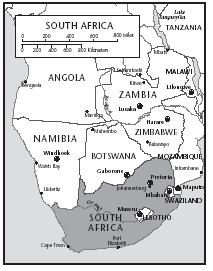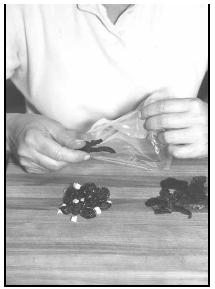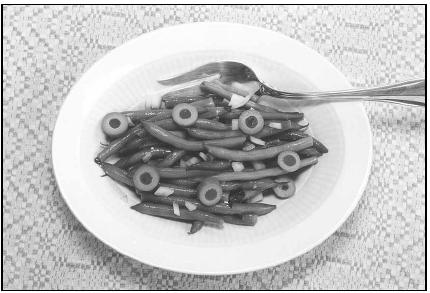South Africa
Recipes

1 GEOGRAPHIC SETTING AND ENVIRONMENT
South Africa is a large country at the southern tip of the African continent. It is slightly less that twice the size of Texas. The country has large areas of plateaus, with some areas of higher elevations in the eastern Drakensberg Mountains, near the border with Lesotho. Over 80 percent of South Africa's land could be farmed, but only about 12 percent is devoted to agriculture. The main crop is corn (called "mealies" in South Africa). Wheat can only be grown in winter, when the climate is like the Northern Hemisphere's summer. "Kaffir corn," which is really sorghum (a grass similar to Indian corn), is another important crop. South African farmers also raise livestock, but their herds do not produce enough meat to feed the population. Meat is imported in the form of live animals from neighboring Namibia and Botswana.
2 HISTORY AND FOOD
Early South Africans were mostly hunter-gatherers. They depended on foods such as tortoises, crayfish, coconuts, and squash to survive. Biltong , meat that is dried, salted, and spiced (similar to jerky), and beskuits (dried sweetened biscuits, like zwiebeck or rusks) were popular food among the original pioneers and are both still enjoyed by twenty-first century South Africans. Dried fruits, eaten whole or ground into a paste, are also popular treats. The practice of modern agriculture was introduced by the Bantu, natives of northern Africa. They taught inhabitants to grow vegetables such as corn ("mealies"), squash, and sweet potatoes. Modern Zulu people, most of whom live in northeastern South Africa, enjoy a soft porridge made from mealie-meal (cornmeal), and dishes combining meat and vegetables such as dried corn and yams.
Nearly 200 years after the Portuguese first arrived in South Africa, Dutch settlers,

Other countries also brought diversity to South African cuisine. The French, known for making wines, began establishing vineyards. The Germans introduced baked goods and pastries and the British brought meat pies. Foods from India, China, and Indonesia also influenced the South African diet.
Early settlers simmered potjiekos (stew) for hours in a three-legged iron pot over a very small open fire. Ingredients would be added to the pot of potjiekos as they became available, such as animals caught by hunters or trappers and vegetables or wild plants harvested from the open fields.
Traditional Biltong and Dried Fruit Snack
Ingredients
- Beef jerky, any style (commercially packaged)
- Dried apricots or plums (prunes)
Procedure
- Cut beef jerky strips into bite-sized pieces (½- to 1-inch)
- Put pieces of biltong in a baggie or wax-paper sandwich bag.
- Put a few pieces of dried fruit in the baggie.
- Carry the biltong (jerky) and dried fruit as traditional South African snacks to enjoy anytime.
3 FOODS OF THE SOUTH AFRICANS
Seafood, a staple food in South African diets, is plentiful along the country's Atlantic and Indian Ocean coastlines. Hake is the most common fish, caught in the Atlantic Ocean waters. It is sold as "fish and chips" (pieces of deep-fried fish with French fries)

South Africa's mild climate produces a variety of fruits and vegetables. Potatoes, cabbage, corn ("mealies"), sunflower, peppers, and green beans are commonly grown. The abundance of rain in the northern tip of the country allows tropical fruits to grow, including bananas, pineapples, and mangoes. Such fruits make delicious desserts.
Dishes of British origin are seasoned and flavorful in South Africa. Spices were added to popular meals, such as the meat pie. The Boer (Dutch) Chicken Pie is a crusted chicken potpie with plenty of seasonings, topped with eggs and ham. Bobotie , a beef or lamb potpie, contains raisins, apples, almonds, and curry powder, a savory seasoning.
Sausages (made of beef or pork) and sosaties , seasoned lamb on a skewer, are commonly eaten at meals. Sosaties are most frequently served at a barbecue, or braai , party and served with sauce and biscuits. South Africans make sosaties in different ways, with a variety of seasonings to make the meal more flavorful. Other meat favorites are ostrich and chicken. Frikkadels ("little hamburgers" usually seasoned with nutmeg) are sometimes served wrapped in cabbage leaves. Bredies , meat and vegetable stews of all kinds, are usually named for the primary vegetable ingredient (such as carrot bredie or tomato bredie). Wine, water, mechow (a fermented beer-like drink made from cornmeal), and tea are often served with meals. Rice pudding, melktert (milk custard tart), and cookies remain popular desserts.
Mealie Soup (Corn Soup)
Ingredients
- 4 Tablespoons butter
- 1 cup onions, finely chopped
- 2 tomatoes, chopped
- 2 cups canned whole corn, well drained
- 2 cups creamed corn
- 1 can evaporated milk
- 3 cups chicken broth (about 1½ cans)
- 1 Tablespoon salt
- 1 teaspoon black pepper.
Procedure
- In a large saucepan, melt the butter over moderate heat.
- Add the onions and sauté for 5 minutes.
- Stir in the tomatoes and cook for a few more minutes.
- Add the corn, milk, chicken broth, salt, and pepper. Simmer for 15 minutes.
- Serve with crackers.
Serves 6 to 8.
Carrot Bredie
Ingredients
- 1 onion, chopped
- 1 Tablespoon oil
- 8 carrots, washed, scraped, and chopped
- 2 potatoes, washed, scraped, and chopped
- Pinch of salt
- Pinch of black pepper
- 1 cup water
Procedure
- Measure the oil into a skillet, and heat over medium heat.
- Add the chopped onion, and cook until the onion is golden brown.
- Add the vegetables and the seasoning.
- Add the water and stir. Bring the mixture to a boil.
- Reduce the heat and place a cover on the pot, but leave it ajar, to allow steam to escape.
- Let the bredie simmer until the water has evaporated and the vegetables are soft. Remove from heat and mash.
- Serve immediately with a little butter stirred in.
Serves 8 to 10.
Green Bean Salad
Ingredients
- 2 pounds fresh, whole green beans, trimmed at ends
- 1 cup white onions, thinly sliced
- ½ cup salad oil
- 4 Tablespoons lemon juice
- 1 teaspoon salt
- ½ teaspoon pepper, freshly-ground
- ¼ cup stuffed olives, sliced
Procedure
- Heat a saucepan full of salted water to boiling. Add green beans and simmer, covered, until green beans are tender (about 15 minutes).
- In a separate bowl, combine onions, salad oil, lemon juice, salt, ground pepper, and stuffed olives.
- Drain the cooked green beans, and while still hot, toss quickly with onion mixture.
- Cover and refrigerate for at least 2 hours.
- Serve as a main course for lunch or light supper.
Makes 8 servings.
4 FOOD FOR RELIGIOUS AND HOLIDAY CELEBRATIONS
More South Africans practice Christianity than any other religion. Like other Christians around the world, South African Christians celebrate Christmas Day on December 25 and Good Friday and Easter in either March or April. Such occasions are normally celebrated with family and close friends.

A typical holiday menu may include rock lobster tail or seasoned lamb or pork accompanied by cabbage. Serving appetizers depends on the size of the dinner. People want to save room for dinner, dessert, and after-dinner drinks. Sambals (condiments such as chopped vegetables and chutneys), atjar (pickled fruits and vegetables), yams, geel rys (yellow rice), and green bean salad are popular side dishes. Mealie bread (corn-bread) is a South African favorite and is often served before or during the meal. Wine, beer, tea, or water may be refreshing to adults, while children may enjoy soft drinks or other non-alcoholic beverages. Rooibos tea (pronounced roy boy), a strong, caffeine-free herbal tea made from a plant that is native to South Africa, is served without milk, sugar, or lemon. Rice pudding is a common dessert. No matter what meal is chosen, it is certain to be full of flavor.
A much smaller number of South Africans are either Muslim or Hindu. Muslims celebrate the Islamic holiday of Ramadan, a movable month-long holiday. During Ramadan, Muslims fast (avoid eating and drinking) from sunrise to sunset to worship and practice self-control. After sunset, people gather together to enjoy dinner, called iftar . Dinner may include rice, dates, and a variety of spiced dishes. Hindus celebrate Diwali , or Festival of Lights. On this important day, the Hindus eat a small portion of lamb, chicken, or fish with beans or lentils. Their festive dishes often contain up to fifteen different spices and are accompanied by bread.
Komkomer Sambal (Cucumber Relish)
Ingredients
- 3 medium-sized fresh cucumbers, peeled and seeded
- 1 teaspoon sea salt
- 1 Tablespoon cider vinegar
- 1 clove garlic, finely minced
- 1 teaspoon jalapeno pepper, finely minced
Procedure
- Grate the cucumbers on the large holes of a hand grater into a salad bowl.
- Sprinkle them with the salt and let them stand for 2 hours.
- Drain them in a colander, pressing out the liquid.
- Add the vinegar, garlic, and jalapeno pepper and mix well.
- Cover with plastic wrap and chill for at least 1 hour.
Serves 6.
Geel Rys (Yellow Rice)
Ingredients
- 1 Tablespoon sugar
- ½ teaspoon turmeric
- 1 Tablespoon salt
- 2 Tablespoons butter
- 1 cinnamon stick
- 1 cup raisins
- 1 teaspoon lemon rind
- 2 cups white rice
Procedure
- In a large pot, bring 6 cups of water to a boil.
- Add all the ingredients (except rice) to the boiling water and stir until the sugar has dissolved.
- Add the rice, cover, and simmer for 20 minutes. Remove the cinnamon stick and lemon rind before serving.
5 MEALTIME CUSTOMS
South Africans eat three meals per day. For breakfast, most eat some kind of hot cooked cereal, such as putupap (cornmeal porridge, similar to grits), served with milk and sugar. Putupap and mealie bread (corn bread) are frequently also served as part of a main meal and lunch or dinner, too. Other breakfast foods might be beskuit, a crusty, dried sweet bread (similar to rusks). Tea and coffee are popular morning beverages.
South Africans are known for their hospitality and love to cook for visitors. During a hearty meal featuring a main course such as bobotie, seafood, or mutton stew, accompanied by vegetables and rice, it not uncommon for a host to offer guests a variety of drinks, such as wine, homemade beer, or tea. Fruits, puddings, and cakes round off a great meal.
Corn on the Cob
Ingredients
- 6 large ears of fresh corn
- Butter, salt, and chile powder, to taste
Procedure
- Bring 2 quarts (8 cups) of water to a boil in a heavy saucepan.
- Strip the corn of its husks and silky strings and place the ears in the boiling water. Cook for 5 minutes.
- Serve hot and season to taste with butter, salt, and chile powder.
Serves 6.
Bobotie
Ingredients
- 1 pound ground beef or ground lamb (or may use half and half)
- 1 cup onions, thinly sliced
- 1 tart apple, peeled, cored, and chopped
- 2 slices of white bread soaked in milk
- 2 Tablespoons curry powder
- ½ cup raisins
- 2 Tablespoons slivered almonds
- 2 Tablespoons lemon juice
- 1 egg
- Turmeric, dash
- 2 bay leaves
Ingredients for topping
- 1 egg
- ½ cup milk
Procedure
- Preheat oven to 325°F.
- Brown ground meat in a large skillet. Drain off fat.
- Add the chopped onions and cook for about 5 minutes, until onions are softened.
- Add the chopped apple.
- Squeeze out excess milk from bread slices and add them to skillet, tearing the softened bread apart to blend it with the meat mixture.
- Add curry powder, raisins, almonds, lemon juice, 1 egg, and turmeric. Stir well to combine.
- Grease a 9-inch by 13-inch baking dish. Pour mixture into the dish and lay bay leaves on top.
- Bake 40 minutes. Remove from oven.
- Mix egg and milk together for topping, and pour over meat mixture.
- Return dish to oven and bake for 15 minutes more. Remove bay leaves before serving.
Unlike in the United States, foods are seldom packaged for convenience. Bread is rarely pre-sliced and preservatives are not widely used. National laws determine store hours, particularly for meat sellers, who often open as early as 5:30 A.M. and close as early as 1 P.M. For those who can afford it, a servant may be hired to help prepare meals and travel to the stores at early hours.
Lunch may be a simple meal, such as a sandwich or soup. Students returning from school may enjoy a fruit drink, similar to a smoothie, as a between-meal snack. Fresh fruits such as pineapple are often the basis for these refreshing beverages.
Pineapple Sherbet (Pineapple Smoothie)
Ingredients
- 1 medium-sized ripe pineapple (Canned may be substituted.)
- 8 cups water (approximately)
- Juice of 4 lemons
- Sugar, to taste
Procedure
- Peel and core the pineapple. Cut up the fruit, and place it in a blender. Blend to a thick pulp. (Canned pineapple may be substituted.)
- Place the pulp in a large pitcher, add the water, lemon juice, and sugar, and mix thoroughly.
- Put the pitcher in the refrigerator to chill the sherbet beverage.
- Just before serving, stir well. Serve over ice in tall glasses.
Serves 6 to 8.
Dinner may be simple or formal. South Africans may serve dinner on their finest dishes and silverware, placed on a white tablecloth with a centerpiece of flowers or fruit. Salt and peppershakers are almost always available, along with various condiments. In addition, several beverage options are usually on the table. Tea is enormously popular in South Africa, particularly in the early morning. Guests may be awakened by their hostesses as early as 5 or 6 A.M. to enjoy morning tea.
South Africans also like to eat out, whether it is a back porch barbecue ( braai ), at a restaurant, or at a sporting event. Biltong , similar to strips of jerky, is as popular a snack as popcorn is in a movie theater in the United States.
Putupap (Cornmeal Porridge)
Note: Although not authentic, instant polenta may be prepared as an approximate substitute.
Ingredients
- 3 cups water, boiling
- 2 teaspoons salt
- 1 pound fine white corn meal
- ½ cold water
Procedure
- Bring 3 cups of water to a boil.
- Pour meal into center of water to form a pile. Add salt, but do not stir.
- Remove pot from stove. Put lid on and let it sit for 5 minutes.
- Stir, return to heat and simmer over very low heat until putupap is fine-grained and crumbly.
- Stir with a fork or wooden spoon, add cold water, and simmer for another 30 minutes.
- Serve with tomato sauce or gravy.
6 POLITICS, ECONOMICS, AND NUTRITION
From 1948 until 1994, South African society was strictly divided according to racial groups in a structure called apartheid, or racial separation. While the government officially referred to this structure as "separate development," there were, in reality, few resources devoted to development of the black portions of the country. In 1994, the policy of apartheid ended and a multiracial government was elected. Since then, the economy has been adjusting to the new structure of society. Some areas of the economy, such as tourism, suffered because people were concerned that the changes might lead to instability. At the beginning of the twenty-first century, the white minority population enjoyed a high standard of living, but the 85 percent majority black population still lived with low health and economic standards of living.
7 FURTHER STUDY
Books
DeWitt, Dave. Flavors of Africa: Spicy African Cooking from Indigenous Recipes to those Influenced by Asian and European Settlers . Rocklin, CA: Prima Publishing, 1998.
Hachten, Harva. Best of Regional African Cooking . New York: Hippocrene Books, Inc., 1998.
Harris, Jessica B. The African Cookbook: Tastes of a Continent . New York: Simon & Schuster, 1998.
Sandler, Bea. The African Cookbook . New York: First Carol Publishing Group, 1993.
Web Sites
Eating the South African Way. [Online] Available: http://cwr.utoronto.ca/cultural/english/safrica/eating.html (accessed January 31, 2001).
Ethnic Cuisine: Africa. [Online] Available: http://www.sallys-place.com/food/ethnic_cuisine/africa.htm (accessed January 30, 2001).
Islamic Holidays and Observances. [Online] Available: http://www.colostate.edu/Orgs/MSA/events/Ramadan.html (accessed January 31, 2001).
South Africa: What to Eat. [Online] Available: http://www.globalgourmet.com/destinations/southafrica/safrwhat.html (accessed January 30, 2001).
The South African Expat's One-Stop On-Line Resource. [Online] Available: http://www.rsaoverseas.com/features/recipes.htm (accessed August 17, 2001).
"Unlike in the United States, foods are seldom packaged for convenience." Not true.
"Bread is rarely pre-sliced and preservatives are not widely used." Not true & Not true
"National laws determine store hours, particularly for meat sellers, who often open as early as 5:30 A.M. and close as early as 1 P.M." Where do you get your information from?
"For those who can afford it, a servant may be hired to . . . travel to the stores at early hours." Never heard of this nor seen it.
"Students returning from school may enjoy a fruit drink, similar to a smoothie, as a between-meal snack." Certainly not the norm.
After reading this article, i have no confidence in reading what you have written about the food in other countries.